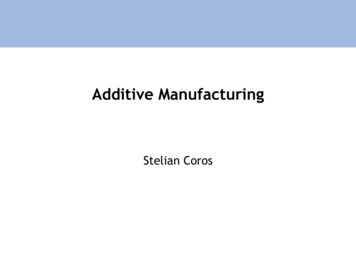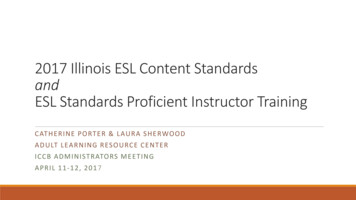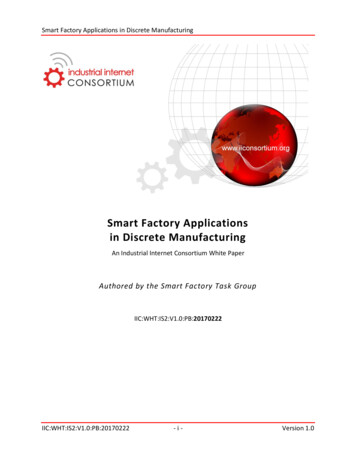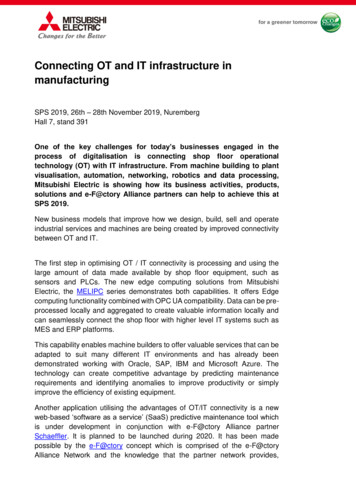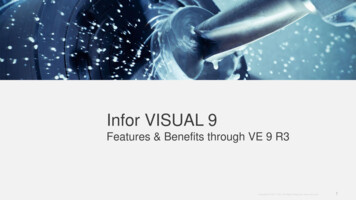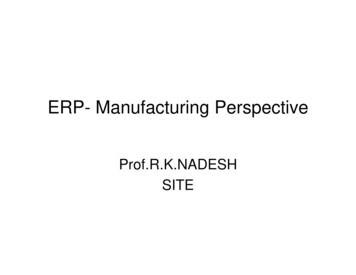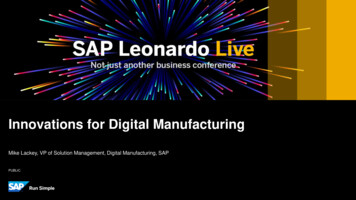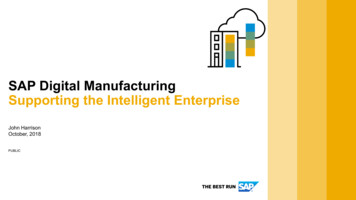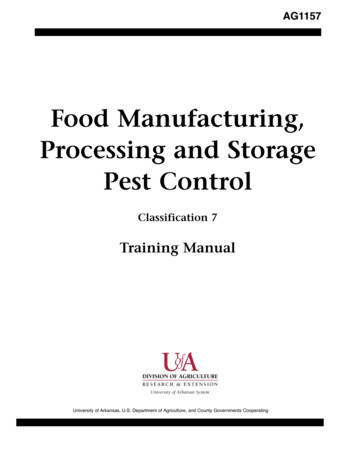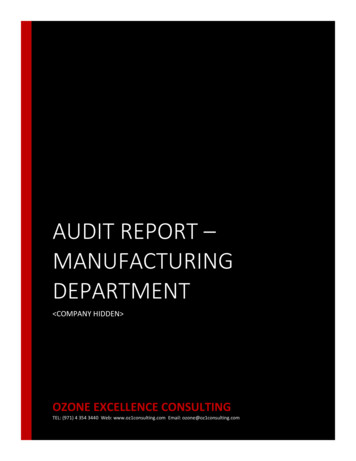
Transcription
Additive Manufacturing – Standards.Alex Price, Lead Programme Manager.Copyright 2013 BSI. All rights reserved.
So how many standards are there?PAS 181:2014 - Smart city Framework. Guide toestablishing strategies for smart cities andcommunitiesBS 185-6:1970 - Glossary of aeronauticaland astronautical terms. Ballistic andguided missilesCopyright 2013 BSI. All rights reserved.BS 8445:2012 - Bath and shower mats. Testing.Assessment of slip resistance properties safetysignsBS 8888:2011 - Technical product documentationand specification03/02/201722
Who sets all these standards? Someone has an idea?National Standards BodyCopyright 2013 BSI. All rights reserved.03/02/201733
Why adopt a standard/s: Required: Recommended: The standard may form part of acontract, The Standard may be part ofobligation to CE or some otherquality mark, Information: A good rationale would bepresented, adoption of the standardmay improve business performance, Elements from a standard could betaken into company best practisewithout full adoption, May improve business practice, May form part training potentiallyfor employees, The Standard may be referred to inlegislation, A very large percentage of export isinfluenced by the European andinternational standards business, The Standard may be requiredwithin the supply chain. May form part training potentially foremployees, Could form guidance to day to daybusiness. Interoperability with otherstandardised products orcomponents.Copyright 2013 BSI. All rights reserved.03/02/20174
Additive Manufacturing – where’s the hypeImage courtesy of NIST Economist February 2011.Copyright 2013 BSI. All rights reserved.Image new scientist July 2012.03/02/20175
Why Standardisation? Any number of reports have highlighted the need. Industry request. Key Challenged hindering advancement of AM over the next ten years. Report by the IQPC 76% of respondents highlighted certification of finished parts and products. 48% Quality & standardisation of material inputs 36% Questionable quality of finished partsCopyright 2013 BSI. All rights reserved.03/02/20176
So many processes, materials and outputs under the additive manufacturingbanner. There are a number of processes which fall under the Additive Manufacturing label. Which vary inmaterial, process, final shape, surface finish, geometrical shape required. The American Society forTesting and Materials (ASTM) group “ASTM F42 – Additive Manufacturing”, formulated terminologydefining range of Additive Manufacturing processes into 7 categories ISO/ASTM52900-15 StandardTerminology for Additive Manufacturing – General Principles – Terminology: VAT PhotopolymerisationBinder JettingMaterial JettingMaterial ExtrusionPowder Bed FusionSheet LaminationDirected Energy DepositionCopyright 2013 BSI. All rights reserved.03/02/20177
Top level overview of the development of standards.NIST publication on AM.Copyright 2013 BSI. All rights reserved.03/02/20178
What new areas is Additive manufacturing linked to? Machine Safety Laser safety Contained atmospheres Metrology: Both established mechanical properties state of the art ultra-high accuracy multi-sensory coordinate measurement machines. Non Destructive Evaluation in-process and post process: For post build inspection for both surface and sub-surface monitoring, digital x-ray, X-ray CTultrasound. Eddy current may be used for surface and close to surface monitoring. For in-process sensors, thermal and optical imaging. Intelligent automation: Complex automation Robotics Sensor technology, embedded.Copyright 2013 BSI. All rights reserved.03/02/20179
What is Quality management for AM? System: Level of assurance of part. Aerospace Robust systems of traceability. Standards Training and New technology requires it Process: What AM process is the most appropriate for your task.System: Some possiblecertification typestandard. Possibly ISO9001 or equivalentindustrial sector such asaerospace (AS 9120) ormedical (ISO 13485) forexample. Choice of materials. Knowing your key parameters. In process monitoring. Post processing. What needs to be done to get the part up to required levels. Next process consideration. Materials:Material: Consistent andreliable feedstockmaterial. Keycharacteristics reportedsuch as; chemicalcomposition and size.Process: With currentlyseven differentprocesses, andvariations of differentmaterials and grades ofin the use. What AM material can be used. Is it the most appropriate for your task. Choice of materials.Copyright 2013 BSI. All rights reserved.03/02/201710
So what are the standards program currently? ISO 17296-2:2015 Additive manufacturing -- General principles -- Part 2: Overview of process categories and feedstock ISO 17296-3:2014 Additive manufacturing -- General principles -- Part 3: Main characteristics and corresponding test methods ISO 17296-4:2014 Additive manufacturing -- General principles -- Part 4: Overview of data processing ISO/ASTM 52900:2015 Additive manufacturing -- General principles -- Terminology 60.60 ISO/ASTM DIS 52901.2 Additive manufacturing -- General principles -- Requirements for purchased AM parts ISO/ASTM NP 52902 Additive manufacturing -- General principles -- Standard test artifacts ISO/ASTM DIS 52903-1 Additive manufacturing -- Standard specification for material extrusion based additive manufacturing of plasticmaterials -- Part 1: Feedstock materials ISO/ASTM CD 52903-2 Additive manufacturing -- Standard specification for material extrusion based additive manufacturing of plastic materials-- Part 2: Process -- Equipment ISO/ASTM NP 52905 Additive manufacturing -- General principles -- Non-destructive testing of additive manufactured products ISO/ASTM DIS 52910.2 Guidelines for additive manufacturing design ISO/NP TR 52912 Design of functionally graded additive manufactured parts ISO/ASTM 52915:2016 Specification for additive manufacturing file format (AMF) Version ISO/ASTM 52921:2013 Standard terminology for additive manufacturing -- Coordinate systems and test methodologiesCopyright 2013 BSI. All rights reserved.03/02/201711
How can standards support the development?PostprocessmonitoringIn processmonitoringMachinerySafetyTypes of AMprocessesandcalibrationMechanical,thermal, etcTestingDimensionalmetrologyGuidanceand bestpractiseCopyright 2013 BSI. All rights reserved.03/02/2017Dataformats andretentionConsistentrawmaterials12
Types of AM process Material extrusion ISO/ASTM CD 52903-2Additive manufacturing -- Standard specification for material extrusion based additivemanufacturing of plastic materials -- Part 2: Process -- Equipment Powder bed fusion Draft DIN 35224: Welding for aerospace applications – Acceptance inspection of powder bed based laser beamwelding machines for additive manufacturing” Draft DIN TBD: Aerospace — Powder for additive manufacturing with powder bed process – Technicalspecification Material jettingBinder jettingDirected Energy depositionSheet laminationVat polymerisation Draft DIN TBD: “Welding for aerospace applications – Qualification of operators for additive manufacturingequipment” Draft DIN TBD: “Testing and Inspection of additively manufactured products” ISO 17296-2:2015 Additive manufacturing -- General principles -- Part 2: Overview of process categories andfeedstock Copyright 2013 BSI. All rights reserved. 03/02/201713
In process monitoring AM NDT standards will require consideration of particular number of defects and assessment of thesurface monitoring during the build, where thermal monitoring, optical imaging and geometricalmonitoring would be useful. For in-process sensors to provide non-destructive evaluation and allowfor early detection of flaws/defects, also modelling on residual stresses based on work at the STFC,neutron source. Thermography: BS ISO 18434-1:2008 Condition monitoring and diagnostics of machines. Thermography. General procedures ASTM E1311-14 Standard Practice for Minimum Detectable Temperature Difference for Thermal Imaging Systems Visual inspection: Very much an objective method based human experience and hence virtually impossible to standardise. Ultrasonic: BS EN 583-1:1999 Non-destructive testing. Ultrasonic examination. General principles Computer tomography (CT): BS EN 16016-3:2011 Non destructive testing. Radiation methods. Computed Tomography. Operation andinterpretationCopyright 2013 BSI. All rights reserved.03/02/201714
Post processing monitoring AM NDT standards will require consideration of particular number of defects and assessment of thesurface monitoring during the build, where thermal monitoring, optical imaging and geometricalmonitoring would be useful. For post build inspection the following techniques may be used for bothsurface and sub-surface monitoring, digital x-ray, X-ray CT ultrasound. Eddy current may be used forsurface and close to surface monitoring. Generate best practice guide showing NDT methods potential to inspect AM defects not covered bycurrent standards. Current Work Item: WK49798 – Standard Guide for Intentionally Seeding Flaws in AM Parts WK47031 – Standard Guide for Nondestructive Testing of AM Metal Parts Used in AerospaceApplicationsCopyright 2013 BSI. All rights reserved.03/02/201715
Machine Safety Many of the Additive machines are on the market, so obviously comply with the machinery directive2006/42/EC, making use of the standards below: Some considerations on machinery safety: Laser Explosive atmospheres Hot melt flow of materials Residual powders EC Directive 2006/42/EC standards dealing with the essential requirements. BS EN ISO 12100:2010 Safety of machinery. General principles for design. Risk assessment and risk reduction BS EN ISO 13849-1:2015 Safety of machinery. Safety-related parts of control systems. General principles fordesignCopyright 2013 BSI. All rights reserved.03/02/201716
Consistent raw materials The raw materials are often in the form of powders or wires that can be melted and shaped by a laser. Consistent raw materials. Goes someway to consistent outputs. Guarantees process consistency. Characterization of Additive Manufacturing Materials involves developing measurements and standardsfor characterizing powdered metals—raw materials for additive manufacturing—in terms of particlesize and shape, chemical consistency and size consistency. Work undertaken by NIST. ISO 17296-2:2015 Additive manufacturing -- General principles -- Part 2: Overview of process categories andfeedstock ISO/ASTM DIS 52903-1 Additive Manufacturing -- Standard Specification for Material Extrusion Based AdditiveManufacturing of Plastic Materials -- Part 1: Feedstock materialsCopyright 2013 BSI. All rights reserved.03/02/201717
Data formats and retention 3D printing uses digital chain of information Many CAD formats extant, only some used for data transfer. Information Process Geometry Additive manufacturing file formats: STL: proprietary, but de-facto standard through frequent adoption by CAD software providers STEP: ISO 10303-242:2014 Industrial automation systems and integration -- Product data representation andexchange -- Part 242: Application protocol: Managed model-based 3D engineering STEP-NC: ISO 14649-1:2003 Industrial automation systems and integration -- Physical device control -- Datamodel for computerized numerical controllers -- Part 1: Overview and fundamental principles AMF: BS ISO/ASTM 52915:2016 Specification for Additive Manufacturing File Format (AMF) Version 1.2 3MF:industry consortium including Microsoft, HP, Fit, formLabs, etc.Copyright 2013 BSI. All rights reserved.03/02/201718
Guidance and best practise With the number of processes out there to choose from which one is the best? Considerations (Design for manufacturer/Design for testing): Distinguishing Intermittent Stages of AM Processing Geometry Characteristics Specific to Additive Material Definition Datum/s Functional Requirements Post and pre InspectionCopyright 2013 BSI. All rights reserved.03/02/201719
Why a standards is needed.Technical Report for the Design of Functionally Graded AdditiveManufactured Parts: Ensuring interoperability The report will review of current capabilities and limitations of existing CAD and Finite Element Method (FEM) softwarethat can support the production of Functionally Graded Additive Manufactured parts and existing software has beenused to simulate FG materials that have variation of mechanical properties such as varying elastic modulus of the FGMpiece. Creating market access It will be relevant for those directly involved in the process of product design development and for those responsible forthe material formulation and engineering. Provide source of knowledge The report is aimed at all those involved in Additive Manufacturing industry to describe the concept of functionallyGraded Additive Manufacturing. Creating market acceptance The report will discuss existing gaps in knowledge, the current limitations and suggesting areas for future work. Inparticular, the report will recommend how future guidelines or standards could be developed from this study.Copyright 2013 BSI. All rights reserved.03/02/20172020
Dimensional metrology The principal check in manufacturing. Dimensional metrology instrumentation and post-measurement analysis techniques that will allowthem to keep processes under tight control. Why are checking? Reducing scrap rate and therefore enhancing environmental sustainability. What are checking for? Quality. 378 published standards: BS 8888 Technical product documentation and specification BS 8887-1:2006 Design for manufacture, assembly, disassembly and end-of-life processing (MADE) - Generalconcepts, process and requirements BS 6808-3:1989 Coordinate measuring machines - Code of practiceCopyright 2013 BS
So what are the standards program currently? ISO 17296-2:2015 Additive manufacturing --General principles --Part 2: Overview of process categories and feedstock ISO 17296-3:2014 Additive manufacturing --General principles --Part 3: Main characteristics and corresponding test methods ISO 17296-4:2014 Additive manufacturing --General principles --Part 4: Overview of data processing .
